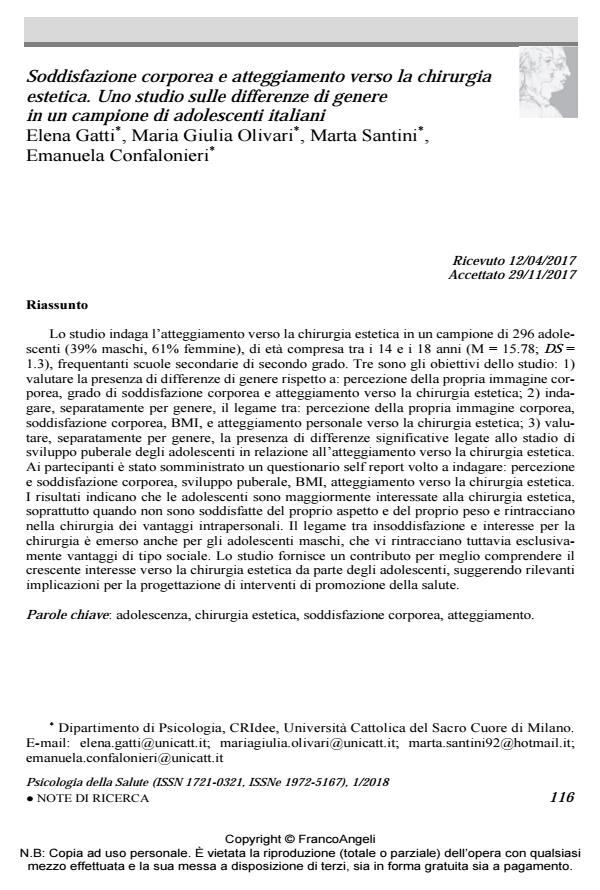Body satisfaction and attitude towards cosmetic surgery. A study about gender differences in a sample of Italian adolescents
Journal title PSICOLOGIA DELLA SALUTE
Author/s Elena Gatti, Maria Giulia Olivari, Marta Santini, Emanuela Confalonieri
Publishing Year 2018 Issue 2018/1
Language Italian Pages 12 P. 116-127 File size 235 KB
DOI 10.3280/PDS2018-001007
DOI is like a bar code for intellectual property: to have more infomation
click here
Below, you can see the article first page
If you want to buy this article in PDF format, you can do it, following the instructions to buy download credits

FrancoAngeli is member of Publishers International Linking Association, Inc (PILA), a not-for-profit association which run the CrossRef service enabling links to and from online scholarly content.
The study investigates the attitude towards cosmetic surgery in a sample of 296 adoles-cents (39% boys; 61% girls) aged 14 to 18 (M = 15.78; DS = 1.3) attending high school in the North of Italy. Three are the main aims of the present study: 1) to evaluate gender differences regarding: body perception, body satisfaction and attitude toward cosmetic surgery; 2) to investigate, separately for gender, relationship between: body perception and body satisfaction, BMI and attitude toward cosmetic surgery; 3) to evaluate, separately for gender, the presence of significative differensces due to pubertal status in relation to attitude toward cosmetic surgery. Participants completed a self-report questionnaire investigating body perception and satisfaction, pubertal status, body mass index and attitude toward cosmetic surgery. The results indicate that girls are more interested in cosmetic surgery, especially when they are not satisfied with their appearance and their weight. Moreover they identify intrapersonal advantages in cosmetic surgery. The link between body dissatisfaction and interest in cosmetic surgery emerged also among males, who identify mainly in cosmetic surgery social advantages. The study contributes to better understand the growing interest in cosmetic surgery by adolescents, suggesting important implications for the design of health promotion interventions.
Keywords: Adolescence, cosmetic surgery, body satisfaction, attitude.
Elena Gatti, Maria Giulia Olivari, Marta Santini, Emanuela Confalonieri, Soddisfazione corporea e atteggiamento verso la chirurgia estetica. Uno studio sulle differenze di genere in un campione di adolescenti italiani in "PSICOLOGIA DELLA SALUTE" 1/2018, pp 116-127, DOI: 10.3280/PDS2018-001007